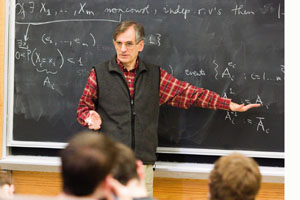László Babai, Professor in Computer Science, Mathematics and the Physical Sciences Collegiate Division
By Steve KoppesNews Office
 László Babai | |
The outstanding tradition of mathematics instruction that took root in Hungary more than a century ago has produced some of the leading figures in 20th-century mathematics, computer science and physics. Now it also has yielded a Llewellyn John and Harriet Manchester Quantrell Award for Excellence in Undergraduate Teaching to László Babai, Professor in Computer Science, Mathematics and the Physical Sciences Collegiate Division.
“I believe that I am bringing a little bit of Budapest into Chicago, but I was absolutely delighted to see that there are colleagues around here who have a very similar philosophy,” Babai says. “I should mention Paul Sally, No. 1.”
Out of the Budapest tradition came the likes of John von Neumann (who made major contributions to quantum physics, game theory and the architecture of modern computers; Eugene Wigner, a 1963 Nobel Prize in Physics winner; and the legendary mathematician Paul Erdös. They, like virtually all the others from a long list of distinguished Hungarian mathematicians of the last century, honed their skills by working problems published in the Hungarian High School Mathematical Monthly.
“These are not routine problems. This is creative problem-solving,” Babai says. “Mathematics is not something to be memorized. It is something to be discovered. And it is possible to transmit this to students on any level.”
Babai took to teaching instinctively in a nation that enjoys a tradition of mathematics instruction and nurturing the gifted that he has found unmatched anywhere outside Eastern Europe. Even in high school, he tutored his classmates. And students two years ahead of him tutored him as well. “Much of what I learned in college, I learned actually by walking in the hallways and learning from students two years my senior,” Babai says. “Teaching was somehow in the air, in the blood, in the atmosphere.”
Erdös was famous for traveling around the world to do mathematics, never staying in one place for more than a few weeks. But whenever he returned to Hungary, he would ask about the “epsilons,” his term for emerging young mathematical talents. Babai himself was pointed out to Erdös as an epsilon at the age of 16. Later, Babai would co-author three papers with Erdös, a coveted distinction in the mathematical community.
Today Babai teaches undergraduate courses in Discrete Mathematics, Algorithms, and the honors course in Combinatorics and Probability, in which he has found the students “a wonderfully inspiring bunch.” In these courses, he delights in conveying the beauty and magic of mathematics to students by showing them the often-surprising connections between seemingly unrelated concepts.
There is, for example, a connection between the bell curve, derived from plotting the outcome of numerous coin flips and pi, the ratio of a circle’s circumference to its diameter. Pi, it turns out, is an element of the formula that describes the bell curve. “How does the circumference of the circle get into the frequency of flipping coins? That just doesn’t make sense,” Babai says. “If that doesn’t surprise somebody, well, OK, then I am going to have to work harder.”
The profoundly human story of mathematics also pervades his instruction. Many people think of mathematics as completely abstract. But to Babai, it is an endeavor tightly bound with human aspirations and struggle, frequent failure and occasional success. Friendships. Rivalries. Betrayals. Jealousies. Secretiveness.
“My heroes are young Paul Erdös’ circle of undergraduate math enthusiasts in the 1930s,” Babai says. In an increasingly menacing climate of anti-Semitism, they took weekly excursions into the hills of Budapest to discuss mathematical problems. “Some major mathematical developments came out of the ideas that were brought to the surface in the discussions of that amazing group of young people.”
Today, students from the United States and Canada can work mathematical problems among those same hills through the Budapest Semesters in Mathematics program. Babai was instrumental in launching the program, which is based at St. Olaf’s College in Minnesota. Students from more than 300 institutions have enrolled in the program during their junior year since it was established in 1985.
“The circle of friends of Paul Erdös initially embraced this program. We started up with zero funding. Absolutely nothing,” Babai recalls. “One can actually get things done on sheer enthusiasm. I would say that that is the foundation of my philosophy.”
![[Chronicle]](/images/sidebar_header_oct06.gif)